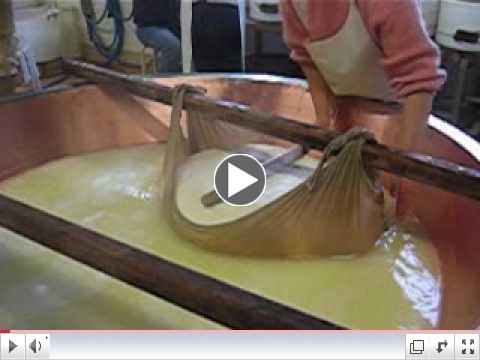|
For thousands of years people have been patiently and carefully exploiting naturally occurring bacteria and the passage of time to make amazingly delicious foods. We caught up with Sarah Spira (cheese buyer) and Julie Biggs (charcutière) at Formaggio Kitchen--a specialty foods retailer--and with Luca Bombarda from Acetum--a manufacturer of balsamic vinegar of Modena--to learn about three traditional foods of the Mediterranean Diet: balsamic vinegar, cheese, and cured meats.
The Mediterranean Diet encourages sparse use of cheese and meat. Small amounts of flavorful meats complement fresh vegetables, and cheeses accentuate flavors in both sweet and savory dishes. Because they are used sparingly, some expensive, traditionally crafted cheeses and cured meats can fit into a budget-conscious menu plan.
Balsamic Vinegar
Production of two types of balsamic vinegar, traditional balsamic vinegar of Modena PDO and balsamic vinegar of Modena PGI, is a time-honored tradition in Modena, Italy. Traditional balsamic vinegar is made of a single ingredient: grape juice. The juice is cooked, resulting in a thick reduction called grape must. The must is aged in a series of wooden barrels of varying sizes. Each year the vinegar reduces by 10 to 15% due to evaporation, absorption into the wood, and absorption into the "mother," the sediment containing healthy bacteria that create the vinegar. Each year some vinegar from each barrel is poured into the next smallest in a process called "topping up." After a minimum of 12 years, the regional Consortium of Producers evaluates the vinegar, and bottles and labels it. The thick, sweet traditional balsamic vinegar is so refined and rich, that it is considered a condiment. Luca's grandfather used to enjoy a sip of traditional balsamic vinegar after his meals as a digestif!
Traditional balsamic vinegar is expensive and scarce because of the painstaking process for making it. In the early 20th century a couple of enterprising retailers in Modena diluted the traditional balsamic with wine vinegar to create a less expensive and easier-to-use product that still retained balsamic flavor. Today vinegar sold as "balsamic vinegar of Modena PGI" is a combination of cooked grape must and wine vinegar.
Buying and Storing Balsamic Vinegar
Luca recommends looking for two things when buying balsamic vinegar:
- The PDO or PGI designation as a guarantee of authenticity.
- A symbol of a chef hat with 1 to 4 vine leaves. Vinegars graded with one leaf are good for salad dressings and basic recipes. Vinegars with 2-3 leaves are better for reductions and marinades. Those with 4 leaves are best used as a condiment or cordial. Compare your intended use with the grade and price to find the right vinegar for your needs.
Store vinegar in a cool, dark location with a tightly closed cap.
Cheese
Making cheese as a means of preserving milk probably dates back about 10,000 years. All cheese starts as fresh milk. The cheesemaker adds enzymes to curdle the milk, causing curds to coagulate and separate from the watery whey. The whey is drained off, and curds are processed according to the type of cheese being made. A wide range of variables are responsible for producing the dramatically different types of cheese available, including: the type of milk being used (cow, sheep, goat); whether the milk is pasteurized or raw; the enzyme used to form the curds; whether the curds are cooked; the rate of change in temperature and acidity of the curds; how the cheese is shaped; the length of time and the environment in which the cheese ages.
Aging cheese reduces moisture content, alters texture, and concentrates flavors. Sarah explained that each cheese has its own peak, when the flavors and textures are best. The peak can differ from batch to batch, so cheesemakers must constantly monitor and tend to their cheeses during the aging process.
See how Parmigiano Reggiano cheese is made:
 | |
Making Parmigiano Reggiano Cheese,
|
Buying and Storing Cheese
Sarah recommends getting to know your local cheesemongers to take advantage of their knowledge. She also recommends buying only the amount you need, and when possible, requesting a fresh piece be cut for you. Look for uniform color and texture in the exposed cut surface. Wrap cheese in cheese paper or wax paper and store it in the vegetable drawer of the refrigerator. Use the cheese within 5 to 7 days to prevent it from drying out or developing off flavors.
Preserved Meats
Curing meat--like cheesemaking--is an ancient means of preserving a nutrient-rich food. Regions throughout the Mediterranean have their own specialties with unique flavors thanks to the local climate, recipe variations, breeds of animals, and animals' diets. Julie uses traditional methods to make exquisite cured meats for Formaggio Kitchen.
One of Julie's specialties is duck pastrami. She starts by dry rubbing whole duck breasts with salt, sugar, and a pinch of curing salt. The meat cures with the dry rub for 4 days, after which she soaks it to remove the salt. She dries the meat overnight, seasons it with pastrami spices, and smokes it for about 20 minutes--long enough to impart a light smoky flavor, but not so long as to cook the meat. She then hangs the duck breasts in a dark cooler to dry for about 2 weeks. Whether she is making pastrami, guanciale, pancetta, or any other preserved meat, Julie tends to her products daily to make sure they are aging properly.
Buying and Storing Cured Meats
Julie recommends tasting before buying. Reputable shops will let you sample their products. Look for uniform color, and white (not yellow) fat. Salamis should be completely dry and have a pleasant earthy aroma from the white mold. You should also be able to smell the salami itself. Avoid any meat with an ammonia-like smell.
Wrapping cured meat in plastic for storage stops the natural aging process, so Julie recommends buying the amount you need the day or day before you need it.
Click on a photo or recipe title below to link to the full recipe: |